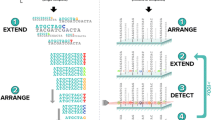Abstract
A marker suitable for genetic mapping and genomic fingerprinting is characterized by high polymorphic information content (PIC) and high “multiplex ratio” (defined as the number of loci that can be simultaneously typed). Towards this goal, we combined an Alu-specific with a non-Alu primer in a single PCR amplification targeting genomic regions where length polymorphisms are abundant. Three loci were revealed with the variable number of (AAT), (TAAA), (AG), and/or (AAAGG) motifs, and PIC values between 0.7 and >0.94. Their location on Chromosomes (Chrs) 19q12, 17q12-q24, and 5q31.2–33.3 was determined by multipoint analysis with markers from CEPH database. The most common genotype for this three-locus marker, estimated from the occurrence of the most frequent alleles, is of the order of 2×10−4, while the combined PIC value of a single typing experiment is 2.37. The use of a similar primer pair, as well as examples from the literature, indicates the general nature of this approach when a non-Alu oligonucleotide, presumably with “random” priming sites downstream of Alu repeats, is combined with an Alu-specific one. Clustering of DNA length variants in the regions adjacent to interspersed repeats provides opportunity to develop other highly informative multiple-locus markers similar to that described here.
Similar content being viewed by others
References
Bernard, L.E., Wood, S. (1993). Human chromosome 5 sequence primer amplifies Alu polymorphisms on chromosomes 2 and 17. Genome 36, 302–309.
Botstein, D., White, R.L., Skolnick, M.H., Davis, R.W. (1980). Construction of a genetic linkage map in man using restriction fragment length polymorphisms. Am. J. Hum. Genet. 32, 314–331.
Chamberlain, J.S., Gibbs, R.A., Ranier, J.E., Caskey, C.T. (1990). Multiplex PCR for the diagnosis of Duchenne muscular dystrophy; in Innis MA, Gelfand DH, Srinsky (eds): PCR Protocols. New York, Academic Press, pp. 272–281.
Collins, F.S. (1992). Positional cloning: let's not call it reverse anymore. Nature Genet. 1, 3–6.
Cuticchia, A.J., Fasman, K.H., Kingsbury, D.T., Robbins, R.J., Pearson, P.L. (1993). The GDB human genome data base anno 1993. Nucleic Acids Res. 21, 3003–3006.
Donis-Keller, H., Green, P., Helms, C., Cartinhous, S., Weiffenbach, B., Stephens, K., Keith, T.P., Bowden, D.W., Smith, D.R., Lander, E.S., Botstein D., Akots, G., Rediker, K.S., Gravius, T., Brown, V.A., Rising, M.B., Parker, C., Powers, J.A., Watt, D.E., Kauffman, E.R., Bricker, A., Phipps, P., Muller-Kahle, H., Fulton, T.R., Ng, S., Schumm, J.W., Braman, J.C., Knowlton, R.G., Barker, D.F., Crooks, S.M., Lincoln, S.E., Daly, M.J., Abrahamson, J. (1987). A genetic linkage map of the human genome. Cell 51, 319–337.
Economou, P.P., Bergen, A.W., Warren, A.C. (1990). The polydeoxyadenylate tract of Alu repetitive elements is polymorphic in the human genome. Proc. Natl. Acad. Sci. USA 87, 2951–2954.
Epstein, N., Nahor, O., Silver, J. (1990). The 3′ ends of Alu repeats are highly polymorphic. Nucleic Acids Res. 18, 4634.
Jeffreys, A.J., Wilson, V., Thein, S.L., Weatherall, D.J., Ponder, B.A. (1986). DNA “fingerprints” and segregation analysis of multiple markers in human pedigrees. Am. J. Hum. Genet. 39, 11–24.
Kaukinen, J., Varvio, S.-L. (1992). Artiodactyl retroposons: association with microsatellites and use in SINEmorph detection by PCR. Nucleic Acids Res. 20, 2955–2958.
Lathrop, G.M., Lalouel, J.M. (1988). Efficient computations in multilocus linkage analysis. Am. J. Hum. Genet. 42, 498–505.
Lathrop, G.M., Lalouel, J.M., Julier, C., Otto, J. (1985). Multilocus linkage analysis in human: detection of linkage and estimation of recombination. Am. J. Hum. Genet. 37, 482–498.
Litt, M., Luty, J.A. (1989). A hypervariable microsatellite revealed by in vitro amplification of a dinucleotide repeat within the cardiac muscle actin gene. Am. J. Hum. Genet. 44, 397–401.
Nakamura, Y., Leppert, M., O'Connell, P., Wolff, R., Holm, T., Culver, M., Martin, C., Fujimoto, E., Hoff, M., Kumlin E., White, R. (1987). Variable number of tandem repeat (VNTR) markers for human gene mapping. Science 235, 1616–1622.
Nelson, D.L., Ledbetter, S.A., Corbo, L., Victoria, M.F., Ramirez-Solis, R., Webster, T.D., Ledbetter, D.H., Caskey, C.J. (1989). Alu polymerase chain reaction: a method for rapid isolation of human-specific sequences from complex DNA sources. Proc. Natl. Acad. Sci. USA 86, 6686–6690.
Saiki, R.D., Scharf, S.J., Faloona, F., Mullis, K.B., Horn, G.T., Erlich, H.A., Arnheim, H. (1985). Enzymatic amplification of β-globin genomic sequences and restriction site analysis for diagnosis of sickle cell anemia. Science 230, 1350–1354.
Sinnett, D., Lavergne, L., Melançon, S.B., Dallaire, L., Potier, M., Labuda, D. (1988). Lesch-Nyhan syndrome: molecular investigation of three French Canadian families using a hypoxanthine-guanine phosphoribosyltransferase cDNA probe. Hum. Genet. 81, 4–8.
Sinnett, D., Deragon, J.-M., Simard, L.R., Labuda, D. (1990). Alumorphs—human DNA polymorphisms detected by polymerase chain reaction using Alu-specific primers. Genomics 7, 331–334.
Skolnick, M.H., Wallace, T.B. (1988). Simultaneous analysis of multiple polymorphic loci using amplified sequence polymorphisms (ASPs). Genomics 2, 273–279.
Tracy, T.E., Mulcahy, L.S.(1991). A simple method for direct automated sequencing of PCR fragment. BioTechniques. 11, 68–75.
Weber, J.L., May, P.E. (1989). Abundant class of human DNA polymorphisms which can be typed using the polymerase chain reaction. Am. J. Hum. Genet. 44, 388–396.
Weissenbach, J., Gyapay, G., Dib, C., Vignal, A., Morissette, J., Millasseau, P., Vaysseix, G., Lathrop, M. (1992). A second-generation linkage map of the human genome. Nature 359, 794–801.
Williams, J., Kubelik, A., Livak, A., Rafalski, K., Tinger, S. (1990). DNA polymorphisms amplified by arbitrary primers are useful as genetic markers. Nucleic Acids Res. 18, 6531–6535.
Zietkiewicz, E., Labuda, M., Sinnett, D., Glorieux, F.-H., Labuda, D. (1992). Linkage mapping by simultaneous screening of multiple polymorphic loci using Alu oligonucleotide-directed PCR. Proc. Natl. Acad. Sci. USA. 89, 8448–8451.
Zietkiewicz, E., Rafalski, A., Labuda, D. (1994). Genome fingerprinting simple sequence repeats (SSR)-anchored PCR amplification. Genomics 20, 176–183.
Zuliani, G., Hobbs, H.H. (1990). A high frequency of length polymorphisms in repeated sequences adjacent to Alu sequence. Am.J. Hum. Genet. 46, 963–969.
Author information
Authors and Affiliations
Rights and permissions
About this article
Cite this article
Tang, J.Q., Korab-Laskowska, M., Jarnik, M. et al. Alu-PCR combined with non-Alu primers reveals multiple polymorphic loci. Mammalian Genome 6, 345–349 (1995). https://doi.org/10.1007/BF00364798
Received:
Accepted:
Issue Date:
DOI: https://doi.org/10.1007/BF00364798




